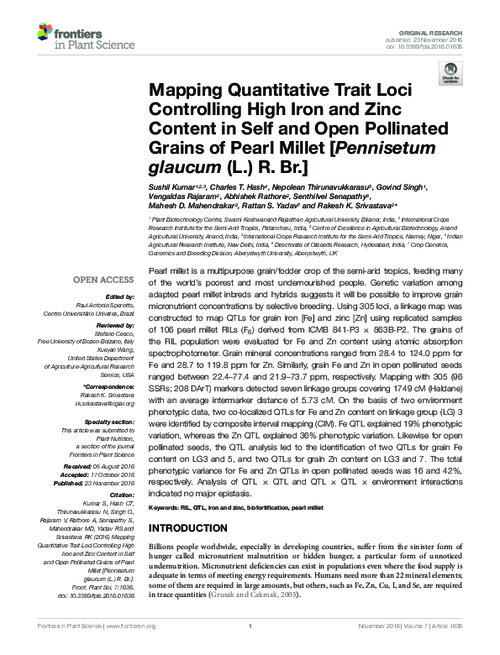Mapping Quantitative Trait Loci Controlling High Iron and Zinc Content in Self and Open Pollinated Grains of Pearl Millet (Pennisetum glaucum (L.) R. Br.)
Abstract
Pearl millet is a multipurpose grain/fodder crop of the semi-arid tropics, feeding many
of the world’s poorest and most undernourished people. Genetic variation among
adapted pearl millet inbreds and hybrids suggests it will be possible to improve grain
micronutrient concentrations by selective breeding. Using 305 loci, a linkage map was
constructed to map QTLs for grain iron (Fe) and zinc (Zn) using replicated samples
of 106 pearl millet RILs (F6) derived from ICMB 841-P3 863B-P2. The grains of
the RIL population were evaluated for Fe and Zn content using atomic absorption
spectrophotometer. Grain mineral concentrations ranged from 28.4 to 124.0 ppm for
Fe and 28.7 to 119.8 ppm for Zn. Similarly, grain Fe and Zn in open pollinated seeds
ranged between 22.4–77.4 and 21.9–73.7 ppm, respectively. Mapping with 305 (96
SSRs; 208 DArT) markers detected seven linkage groups covering 1749 cM (Haldane)
with an average intermarker distance of 5.73 cM. On the basis of two environment
phenotypic data, two co-localized QTLs for Fe and Zn content on linkage group (LG) 3
were identified by composite interval mapping (CIM). Fe QTL explained 19% phenotypic
variation, whereas the Zn QTL explained 36% phenotypic variation. Likewise for open
pollinated seeds, the QTL analysis led to the identification of two QTLs for grain Fe
content on LG3 and 5, and two QTLs for grain Zn content on LG3 and 7. The total
phenotypic variance for Fe and Zn QTLs in open pollinated seeds was 16 and 42%,
respectively. Analysis of QTL QTL and QTL QTL environment interactions
indicated no major epistasis

